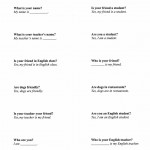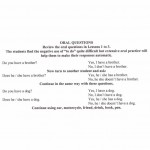Steps for Making Verb Tenses Easier
- Posted by Daisy Stocker
- Date May 16, 2011
- Comments 1 comment

Many students are concerned about learning the tenses of the English language. They have likely heard horror stories about the irregular verbs and the many exceptions to the rules. It is scary unless a method for approaching the tenses in a step by step fashion is introduced. Let's start at the bottom and a pyramid that shows the similarities in the way that the tenses are constructed.
Let’s start at the bottom with the foundation and work to the top – that wonderful point where verb tenses are automatic and the student speaks fluently. Oral and written practice using each step before moving on to the next is vital. The students will need to have extensive practice in the whole class group, the small group, and individually as they write. Practice will make the student’s responses automatic and prevent them from thinking about the grammar. No one can consider grammatical structure as they talk. Each step must be automatic before the students can progress to the next.

Our pyramid might have these steps:

1) The Present Tense
Start with the verb “to be”.
Teach the conjugation of the verb “to be”
Questions:

Are they friendly? Is she happy?
Positive answers: They are friendly. She is happy.
Negative answers: They are not friendly. She is not happy.
Not is placed after the verb “to be”.
Contractions:
Positive: She’s friendly. They’re friendly.
(There are two ways to make negative contraction with the verb “to be”)
Negative: She’s not friendly They’re not friendly.
Or: She isn’t friendly. They aren’t friendly.
Practice many examples.
2) To Do
Explain that most other verbs use “to do” for the negative.

Teach the conjugation of the verb “to do”.
Questions: Do they laugh? Does he walk? Do you answer?
Positive: They laugh. He walks. I answer.
(No other verb is needed for the positive answer)
Negative: The verb “to do” is used with the main verb.
They do not laugh. He does not walk. I do not answer.
Not is placed after the verb “to do”.

3) Contractions
Positive: He laughs. They walk. I answer. (Same format as with “to be”)
Negative: He doesn't laugh. They don't walk. I don’t answer.
(The contraction is made with the verb “to do”)
Practice many examples.
English verbs are complicated but it helps the students if similar patterns are pointed out. The above outline is just one way of organizing the teaching material. As you read it you may find that it sparks new ideas for you to teach this rather complex subject.
ESL Teaching Tips and Strategy
- Teaching Reading Comprehension to Beginners - Teaching reading comprehension to beginner English as a Second Language (ESL) students can be challenging, but with the right approach, it can be fun and very effective. Here are some …
- ESL Student Teachers Ready to Start their First Job - You have arrived at the location of your new English second language teaching position. Your first class of teens and adults begins tomorrow morning. You’re feeling nervous, excited and a …
- How to Improve your Teaching - Many languages of the world are regular in the way that they are structured. This makes English grammar very difficult for thousands of students whose first language follows a consistent …
- ESL Practice Questions – Past Tense – Arctic Balloon Expedition – 1 - Teaching Grammar to English as a Second Language students can be a deadly bore. We’ve seen student sigh and shut their eyes at the thought of it. We know that …
- Suggestions for Maintaining Interest and Control in English Second Language Classrooms - When we at Successful ESL first started teaching ESL classes, one of the very first things that we learned was the alarming student drop out rate, even when you have a good curriculum. There …
- ESL Teaching Activities – Using Prepositions with Printable Handouts - ESL EFL Students from many different cultures find prepositions difficult because their meaning is expressed in a very different way in their own language. The preposition word doesn’t always express its meaning …
- Keeping your ESL Class Alive – tips for ESL Teachers - When you are teaching an ESL class, have you ever stopped and looked at the students’ faces? What do you see? Are the students sitting up, eager to see what …
- ESL Teaching Activities for Beginners – Friendly Greetings - Simple Greetings Activity with Handouts The informal language we use when we meet our friends or family is often idiomatic. ESL beginners can find it very confusing unless they are …
- Tips for Accommodating Advanced Students in ESL Classrooms - Most classes have several students who are more advanced than the others. They learn easily, their assignments are finished quickly, and they can be a behavior problem if they are …
- ESL Students and Their Accents - It is important to remember that everyone has an accent. If we travel from the West Coast of Canada to Toronto, we immediately notice the difference in the people’s accents. …
Date Published: 2011-05-16
Date Modified: 2024-03-08
Daisy Stocker taught ESL in Eastern Europe for 10 years and was a primary school teacher in Canada for 30 years. Daisy has a B.A. and M Ed. in Education.
You may also like
Teaching Reading Comprehension to Beginners
Teaching reading comprehension to beginner English as a Second Language (ESL) students can be challenging, but with the right approach, it can be fun and very effective. Here are some …
ESL Student Teachers Ready to Start their First Job
You have arrived at the location of your new English second language teaching position. Your first class of teens and adults begins tomorrow morning. You’re feeling nervous, excited and a …


1 Comment
Yes nice tips. I remember I had a particular problem with tense when I was learning English many years back.